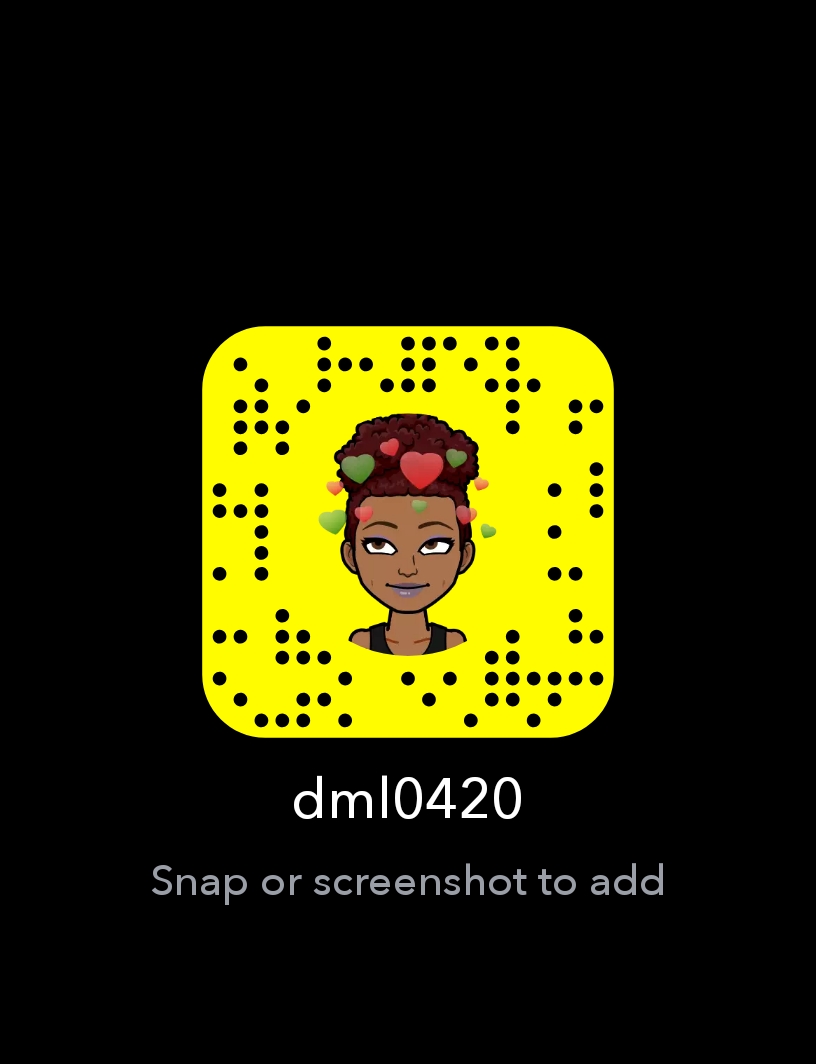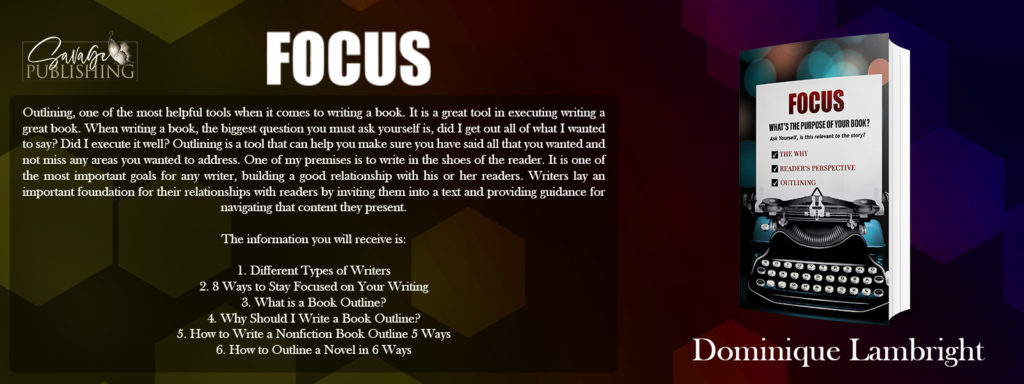Books, Characters, Sneak Peeks
Focus Sneak Peek
Synopsis:
Outlining, one of the most helpful tools when it comes to writing a book. It is a great tool in executing writing a great book. When writing a book, the biggest question you must ask yourself is, did I get out all of what I wanted to say? Did I execute it well? Outlining is a tool that can help you make sure you have said all that you wanted and not miss any areas you wanted to address. One of my premises is to write in the shoes of the reader. It is one of the most important goals for any writer, building a good relationship with his or her readers. Writers lay an important foundation for their relationships with readers by inviting them into a text and providing guidance for navigating the content they present.
The information you will receive is:
- Different Types of Writers
- 8 Ways to Stay Focused on Your Writing
- What is a Book Outline?
- Why Should I Write a Book Outline?
- How to Write a Nonfiction Book Outline 5 Ways
- How to Outline a Novel in 6 Ways

Excerpt:
The Different Types of Writers
Descriptive is a style of writing that focuses on describing a character, an event, or a place in great detail. It can be poetic when the author takes the time to be very specific in his or her descriptions. Sometimes this writer gets too carried away with the description, showing a lack of focus, losing their reader in what is actually happening in the book.
Ex. Steinbeck
An excerpt from Of Mice and Men:
There is a path through the willows and among the sycamores, a path beaten hard by boys coming down from the ranches to swim in the deep pool, and beaten hard by tramps who come wearily down from the highway in the evening to jungle-up near water. In front of the low horizontal limb of a giant sycamore there is an ash pile made by many fires; the limb is worn smooth by men who have sat on it.
Evening of a hot day started the little wind to moving among the leaves. The shade climbed up the hills toward the top. On the sand banks the rabbits sat as quietly as little gray sculptured stones. And then from the direction of the state highway came the sound of footsteps on crisp sycamore leaves. The rabbits hurried noiselessly for cover. A stilted heron labored up into the air and pounded down river. For a moment the place was lifeless, and then two men emerged from the path and came into the opening by the green pool.
Persuasive is convincing others to agree with the author’s point of view, persuasive writing contains justifications and reasons. It is often used in letters of complaint, advertisements or commercials, affiliate marketing pitches, cover letters, newspaper opinion pieces, and editorial pieces.
For this type of writer, they can be so biased in their work that they do not put themselves in the reader’s shoes. They tell about events not giving full details because they already know the event but forget that the reader doesn’t and needs all angles. Leaving the reader lost on what the author was trying to prove at times in their novel.
Ex. 1st person & 3rd person
While both of these POVs are great depending on what type of story you are telling, when in 1st person we can lose focus in what we want the reader to get out of the boo by rambling from one thing to another. And because we only know what the author/narrator is thinking we can give limiting information because WE already know what has happened.
In 3rd person we have more of a range in thoughts, opinions, and character developments because we get viewpoints from several characters rounding out the information. But 3rd isn’t perfect either because we can get lost in the multiple minds that you can jump back and forth to if not focused on the point of the dialogue and narration.
Narrative writing is when the author creates different characters and tell you what happens to them (sometimes the author writes from the point of view of one of the characters—this is known as first person narration). Novels, short stories, novellas, poetry, and biographies can all fall in the narrative writing style. Simply, narrative writing answers the question: “What happened then?”
Sometimes this writer doesn’t answer that question. Which is when you know that they have lost the focus of where they were going with their story. And that is all a matter of having a clear vision for your writing. And knowing what the most important information is to the reader.
The reason I wanted to discuss the different types of writers is to show that there needs to be a balance when writing a story. A lot of the time you must combine these styles to create a well-rounded story for your reader. Without doing so, it can result in lack of focus in your writing.
Ex. Janie (a past client of mine) – lacked description and lacked persuasion; her narration suffered for this and they all go hand in hand:
- Lacking description… in the story she was telling, you could not tell where she was, when things were happening, and how the scenes were progressing forward.
- Lacking persuasion… in her story she would talk about events that happened to her but in no way persuaded the reader that these events affected her positively or negatively; they were just happening without any “impact” to her; or so this is how she portrayed them.
- Lacking narration… she didn’t narrate well to move the story along; I never knew what was happening or when things were happening; there was always a sense of confusion on whether the story was moving forward or backwards.
8 Ways to Stay Focused on Your Novel
I hear many writers say, “I hear a story or read a book and all new ideas pop into my mind. I never end up finishing a book because I start a new one as soon as I started the last! What should I do? How do I stay focused and interested in my old ideas?”
I think most writers deal with this to an extent. For a lot of writers, it tends to be around the halfway point of their current work-in-progress (WIP). That’s when the story starts to feel sluggish, plot lines are a bit out of control, and when tying everything together feels the most overwhelming.
Then you usually find yourself daydreaming about that great idea you had last week, which has even more potential than this current project, and you just know it could be your best book yet. Really, it would be irresponsible to not put aside the WIP in favor of the new project!
If you’re writing just for fun, then I say write whatever you feel like. If it’s just for fun, why force yourself to write stuff you don’t want to? It’s a creative outlet, after all, and there’s no reason to put pressure on yourself. Kind of like pleasure reading. If you’re picking out a book to read for enjoyment, and you like funny, heartwarming books, why would you pick “The Heart of Darkness” when you could read the latest Jennifer Weiner novel?
But if you’ve been putting your writing aside for a while, and you’re at a place where you want to take your writing to the next level and you want to prove to yourself that you can write a full manuscript, then yes, the time has come to stay focused. Here are 8 ways to do that:
1. Make a clear goal
This is huge. Don’t just say, “I’m going to finish this manuscript before I start on any other stories.” Make it concrete. Make it manageable. “I’m going to finish this manuscript by writing 1,000 words a day before I go to bed.”
2. Share your goal
If you have a friend or family member who encourages your writing, tell them about your goal. Ask them if they would please follow up with you. It can be as simple as, “Did you write your thousand words last night?” or “What’s going on in the story now?”
3. Write a synopsis or outline
Sometimes you can have trouble moving forward in the story because you just feel stuck. You don’t know what’s going to happen next (or it’s a scene you’re not looking forward to writing) and your mind starts to wander to those other book ideas you’ve had recently.
This is a great time for you to – if you haven’t already – write a synopsis. It’s just a 2ish page summary of what happens in the book. A lot of times when I do that, when I see how everything will come together, it renews my energy.
4. Brainstorm with a buddy
A lot of times I’ve already written my synopsis, or I’m genuinely stuck. What on earth would my character do next? Or maybe I have an idea, but it feels like a tired, unoriginal idea. When that happens, you can pull in a writing friend. If you don’t have a friend who would be good for brainstorming, think about joining a Facebook Group.
5. Make a story board
The best part about this is being able to tack up character photos, maps of your settings, articles, and various other items that remind you of your WIP. You can use multiple mediums for this such as poster board, cork board, dry erase board, etc. Use what you feel most comfortable using for your display.
6. Create a book cover
I’ve heard other writers say they make book covers for their WIPs. It’s something to remind them of their goal, and that the finished product is well worth the struggle. It could be a fun way to motivate yourself. (Or to encourage other writers you know – make them a book cover to express that you believe in them!)
7. Save your other ideas
Create a system for preserving all those random bits of genius that come your way. A great idea is to keep an Ideas and Inspiration notebook.
8. Give yourself an “other project” writing allowance
If you have an idea that absolutely will not let go, give yourself a time limit (1 day or 2 days) to write down everything you want for that other idea that’s nagging at you. Write the first chapter, character descriptions, themes, whatever you want. Purge yourself of it, then put it away, and get back to work on your WIP.
Want to learn more? Go ahead and buy the book!



